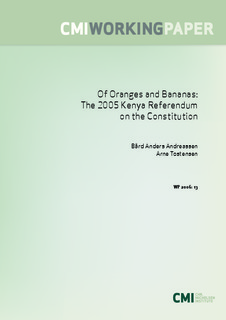| dc.description.abstract | On 21 November 2005, a referendum on a proposed new constitution was held in Kenya, which was conducted in a peaceful and orderly manner. The poll represented the will of the Kenyan people through a process and a vote that were largely free and fair. The campaign was organized in two referendum camps, respectively referred to as Bananas (“yes”) and Oranges (“no”). The proposed new constitution was rejected by 57 per cent of the votes cast, while 43 per cent voted in favour. The voter turnout was slightly above 52 per cent. The print and electronic media covered both sides of the campaign in a balanced manner.
The state-controlled Kenya Broadcasting Corporation, however, was biased in favour of the “yes” campaign. The referendum campaign reconfirmed that Kenyan politics is characterized by ethno-political cleavages, and political loyalty based on ethnicity. It is reasonable to interpret the result as a popular demand for an alternative new constitution, implying that the constitutional issue has not yet been resolved. | |
